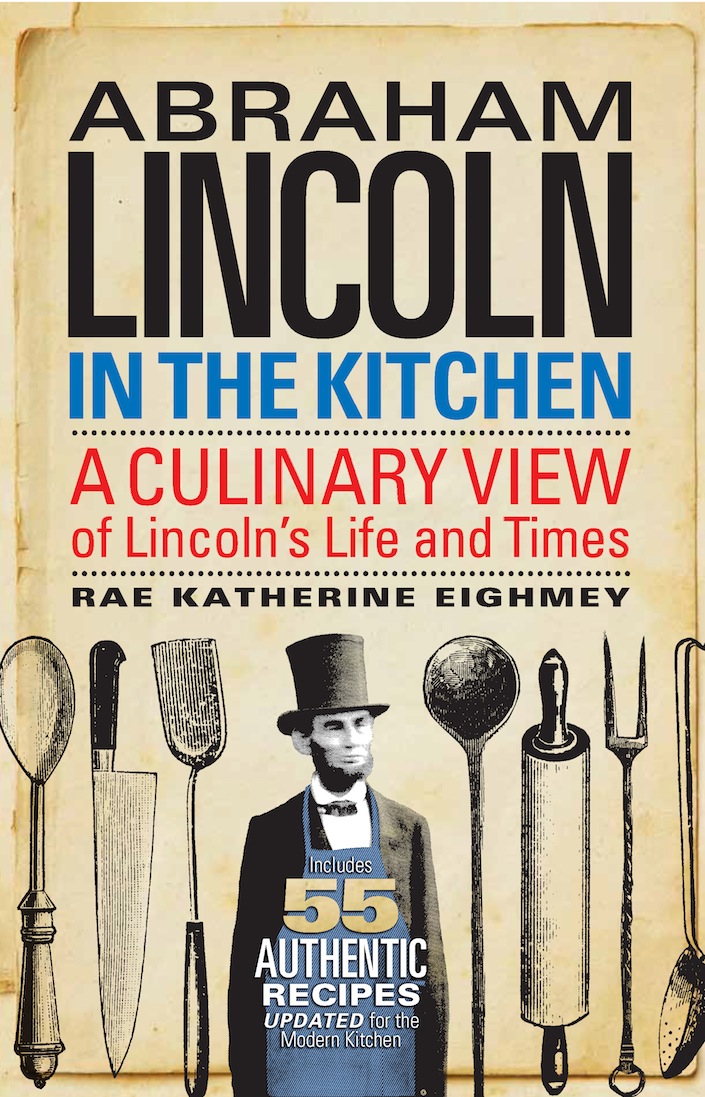“My childhood’s home I see again,
And sadden with the view …
The very spot where grew the bread
That formed my bones, I see.
How strange, old field, on thee to tread,
And feel I’m part of thee!”
—Abraham Lincoln, 1846
It all began in a one-room cabin in Indiana that served as a kitchen, living room, dining room, and bedroom for the Lincoln family. You could say that Lincoln was basically raised in the kitchen. Yet the culinary customs of presidents past are often overlooked in favor of their famous quotes and major accomplishments.
Luckily for us, however, award-winning author and cook Rae Katherine Eighmey paints a presidential portrait of President Abraham Lincoln through food in her new book, “Abraham Lincoln in the Kitchen: A Culinary View of Lincoln’s Life and Times.” Get to know Lincoln at the dinner table with Eighmey’s culinary vignettes.
Corn, in All its Many Forms
Under a tree, with a book in hand, Lincoln often snacked upon corn dodgers—small corn cakes. He also likely enjoyed hominy—grits made from stone-ground corn—and many other corn products due to its ease of cultivation compared to wheat flour.
Corn Dodgers
makes 18 dodgers
Ingredients
2 c coarse cornmeal, preferably stone-ground
1/2 tsp salt
1 Tbsp melted butter or bacon drippings, plus more for cooking dodgers
1-1/2 c boiling water
1/3 c regular cornmeal (optional)
Method
Mix coarse cornmeal and salt. Make a well in center and pour in butter or drippings. Pour boiling water over fat and stir carefully. Cool for 20 to 30 minutes. If needed, add a bit more water or up to 1/3 cup regular cornmeal to make a loose, workable dough. Place 2 tablespoons of dough in the palm of one hand and gently press into an oval 2-inches long and 1-inch wide. Over medium-high heat, melt 1 tablespoon of butter or drippings in skillet. Place dodgers in skillet, lower heat, and cook until bottoms are browned and tops are firm and dry, about 8 to 10 minutes. Flip carefully and finish cooking until browned on both sides, another 5 to 7 minutes.
Recipe adapted from Abraham Lincoln in the Kitchen by Rae Katherine Eighmey, courtesy of Smithsonian Books
The Gingerbread Boy
A gingerbread man was a rarer, but far more beloved, snack of Lincoln’s. His mother once gave him three homemade gingerbread men, which he took to eat beneath a hickory tree. A neighbor boy approached and said, “Gimme a man.” Lincoln gave him one and, as he slowly continued to eat his first, watched the boy gobble his up in two big bites.
“Abe,” said the neighbor boy. “Gimme that other’n.” I want it myself, thought Lincoln, but he gave it to him anyway and watched the boy devour it speedily.
“You seem to like gingerbread,” Lincoln observed.
“I don’t suppose there’s anybody on this earth likes gingerbread better’n I do,” the boy responded. “And I don’t suppose there’s anybody on this earth gets less’n I do.”
Professional Bites
Before his election to the Illinois General Assembly, Lincoln dabbled professionally in the culinary world, filling the shoes of a corn and wheat mill overseer, flatboat trip cook, and general store manager. During his service in the Black Hawk War, Captain Lincoln likely drank whiskey and ate generous amounts of bacon with his troops.
William Herndon, Lincoln’s law practice partner, noted that he frequently ate a breakfast of charcuterie, cheese, and crackers at work. Herndon also described Lincoln’s unique consumption of apples: “He would grasp it around the equatorial part, hold it thus until his thumb and forefinger met, sink his teeth into it, and then … begin eating at the blossom end … I never saw an apple thus disposed of by anyone else.”
The Sweet Life
During Lincoln’s courtship with Mary Todd, she made him an almond cake that he deemed, “the best cake I ever ate.” Whether or not this was a significant factor in their eventual betrothal, it certainly kept Lincoln close to the kitchen. He was even reputed to don a large blue apron himself and help Mary with the cooking on occasion.
According to charge accounts the Lincoln family kept at stores, one of their most popular purchases was sugar. They consumed a whopping gallon of sweet syrup every 10 to 12 days and approximately 11 pounds of sugar every two weeks. Perhaps Lincoln’s sweet tooth kept his wife busy preparing almond cakes and other baked goods by the basketful, or maybe their three sons poured generous amounts of syrup on their pancakes.
Food for Presidential Thought
In political office, Lincoln sustained the generosity he exhibited as a boy during the gingerbread incident. During a political barbecue, Lincoln relinquished his seat at the head of a table for an older waitress and dishwasher known as Granny. After her repeated refusals, he vacated his chair, taking his turkey leg and biscuit to eat beneath a tree.
Aside from being able to afford turkey, pork, and other meats, Lincoln developed an appetite for oysters—but only when cooked. He once refused a raw oysters, noting, “If I should eat a raw oyster with you, it would be the first time I had ever eaten one.”
The dinners surrounding Lincoln’s presidential election were equally memorable. Prior to his inauguration, he feasted upon mock turtle soup, corned beef and cabbage, parsley potatoes, and blackberry pie. After his inauguration, the party dined on a fussier meal of Potomac shad—a river herring—which gave everyone a nasty bout of food poisoning.




